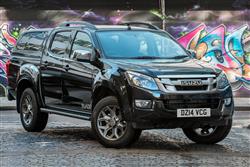Home | Used Car Road Tests | 4x4s | Isuzu D-Max Blade (2014-2015)
Road Test Video
Used Car Model Guide | Isuzu D-MAX Blade (2014 - 2015)
BLADE RUNNER
By Jonathan Crouch
Think pick up and you'll probably reckon on a Toyota Hilux, or a Mitsubishi L200, possibly even a Nissan Navara, a Volkswagen Amarok or a Ford Ranger. If you're in the market for this sort of vehicle on he used market though, there's another name that would be wholly remiss to leave from your shortlist; the Isuzu D-Max. A more refined successor to the bulletproof Rodeo, the D-Max has carved itself a niche in this most hotly-contested sector. Throughout its production life, it was a vehicle that proved to be especially popular in its upper-spec doubecab guises. It was to capitalise on this demand that in 2014, the UK importers introduced the limited-run 'Blade' variant we're going to look at here. Will it make a good used option for lifestyle pick-up buyers? Read on
History
Isuzu used the 'D-Max' name in other markets to designate the Rodeo model that represented it in the UK pick-up segment between 2002 and 2012. When that period ended and the brand was ready to launch an all-new design, the 'D-Max' tag was adopted and the vehicle was successfully introduced into the UK market.
Early sales were strong enough to encourage the British importers to test the market with a very high-spec doublecab variant which they christened the 'Blade' and announced early in 2014. It got eighteen-inch alloys, a roller top cover or a full topper, side steps, tinted windows, heated leather seats, a DAB stereo and a touch screen nav system. This variant was subtly upgraded in the middle of 205, but it's the early version we look at here.
What You Get
The D-Max Blade certainly looks the part, offering those who want a leisure-oriented pick up something that's has some genuine visual impact. Those eighteen-inch six-spoke alloy wheels help here, and they're shod with some meaty-looking 255/60-18 Pirelli Scorpion Zero tyres. The front grille is finished in a shadow grey tone to match the wheels, while the door handles and roof bars are painted black. Even the heavy-duty side steps haven't gone too big in chrome. Two paint finishes were offered. The Splash White looks clean but the Blade definitely looks meanest in mica Cosmic black.
The interior of this double cab looks and feels sturdy, but it's far from basic. There's been some clear attempts at styling, with a circle of minor controls on the centre stack reminiscent of the Mazda RX-8 and a couple of ventilation 'ears' at the top of the fascia that aren't a million miles away from contemporary Ford design. So while it's not scoring top marks for originality, the D-Max fascia gets credit for ease of use, with wheel-mounted controls, big clear clocks, easy access to the most important switches and a good driving position. There's even a decent amount of rear seat legroom, which isn't always the case with double cabs. You also get a 3.5-tonne (braked) towing capacity and a payload capacity of 1,000kg.
What You Pay
Please contact us for an exact up-to-date valuation.
What to Look For
The condition of a used pick-up is very important because the kind of use they've been put through will vary greatly. Check the underside of the vehicle, the sills and the wheels for evidence of off-roading damage and take a good look around the interior of the loadbay. In general, Isuzu has a great reputation for reliability and the mechanicals of the D-Max should be strong enough.
Replacement Parts
(Based on a 2014 2.5-litre D-Max Blade) Front brake discs are around £35 and you'll pay £10 for an air filter. A new turbocharger will be close to £600 and a clutch kit will be around £190.
On the Road
The Isuzu D-Max Blade gets the same fuel efficient 2.5-litre twin-turbo common rail diesel engine as the rest of the D-Max range, offered with a choice of either six-speed manual or five-speed automatic transmissions. This advanced Euro5-compliant unit generates 163PS and peak torque output of 400Nm at 1400 rpm. Like other D-Max models, this one used a 'shift-on-the-fly' system, allowing the driver to adjust between two and four-wheel drive modes while travelling at speeds of up to 60mph.
The front suspension comprises an independent double wishbone with coil-spring set-up, while the rear suspension is made up of over slung leaf-springs installed above a special long span rear axle. Isuzu claimed this offered better driving comfort. Like the Rodeo before it, the D-Max was built on a rugged ladder-framed chassis, but the similarities ended there. The i-GRIP (Isuzu Gravity Responsive Intelligent Platform) underpinnings of the D-Max are 42 per cent stiffer than those of the old Rodeo chassis, helped by improved cross bracing at the rear, which offers superior stability under load and when towing.
Overall
The D-Max Blade proved to be a proper test of Isuzu's growing standing in the lifestyle pick up market. It's certainly hard to think of anything else you could add to it. Eighteen-inch alloy wheels, a DAB stereo, sat nav, climate control, heated leather seats, mica paintwork, a choice of a topper or a roll-top to keep your gear safe - it's all there in the asking price. Few rivals can match that sort of spec and it's blended with a very tough basic product. If you think that sounds like a strong used vehicle proposition, then we wouldn't disagree.
Related Road Tests
Browse the other models
Currently viewing Used Car Road Tests, switch to New Car Road Tests
Select a model to browse through the videos.

.jpg)
.jpg)
.jpg)